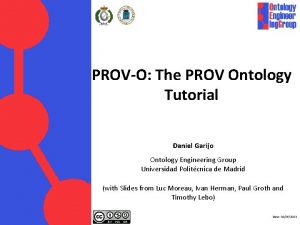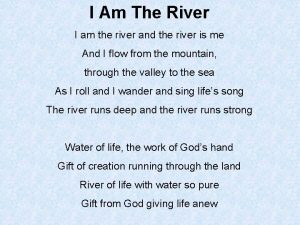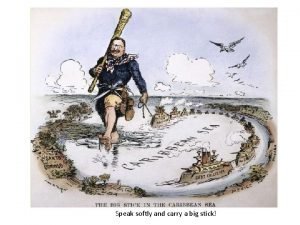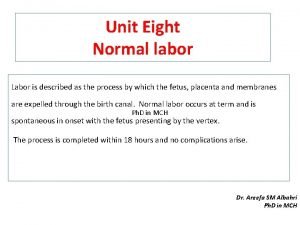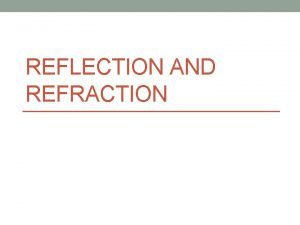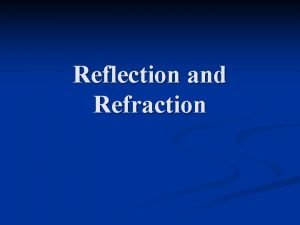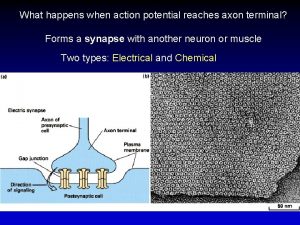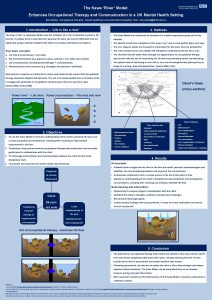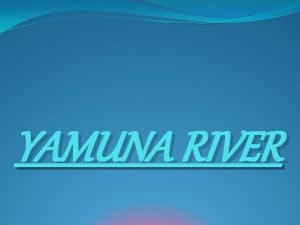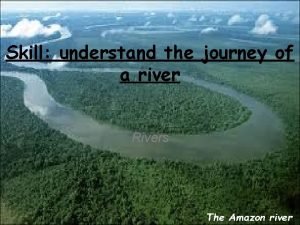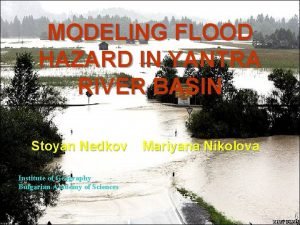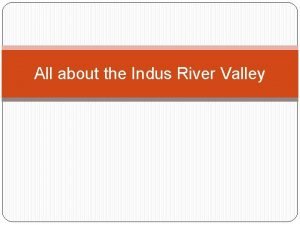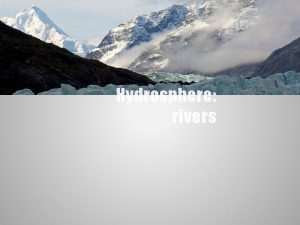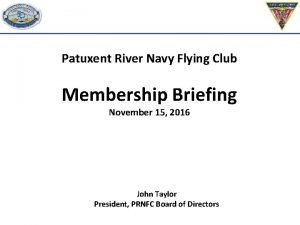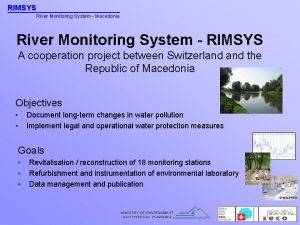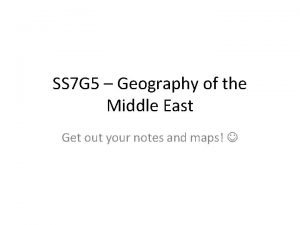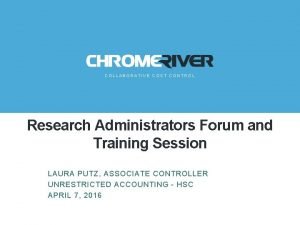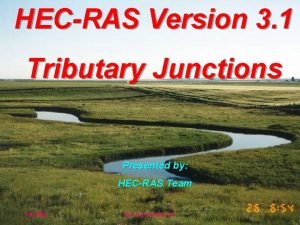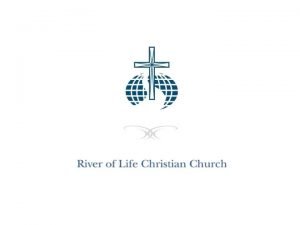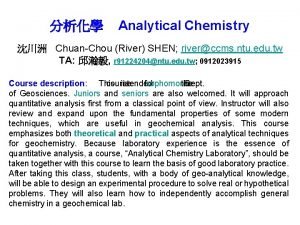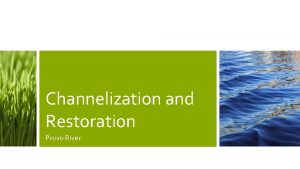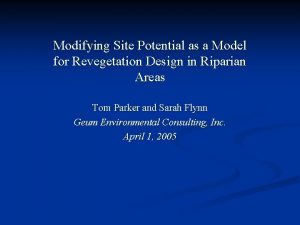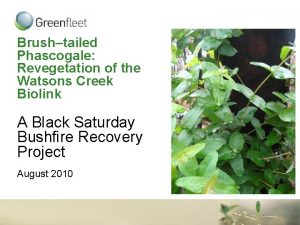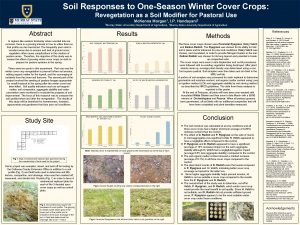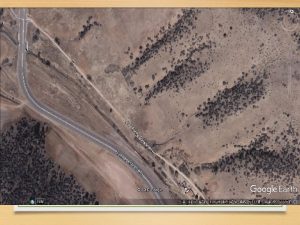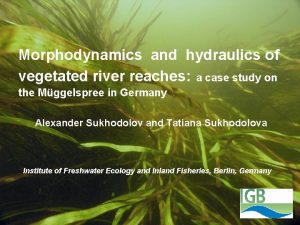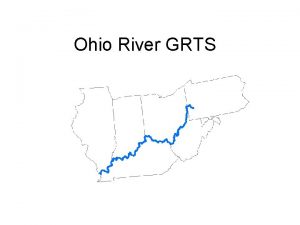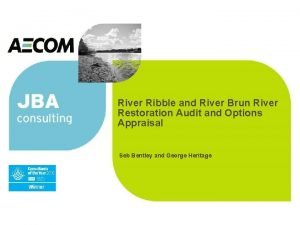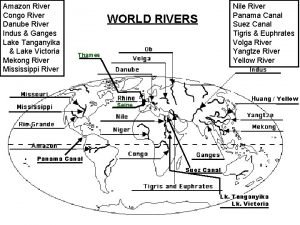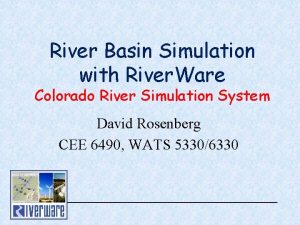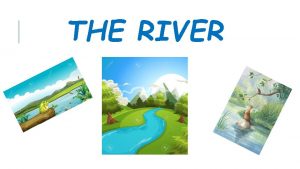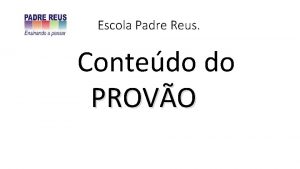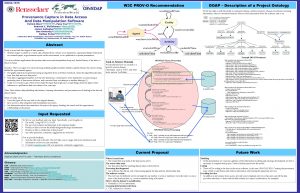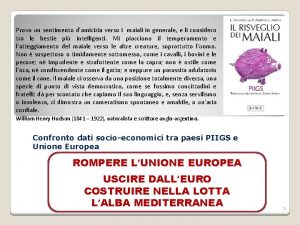Revegetation of Reconstructed Reaches of the Provo River








































































- Slides: 72

Revegetation of Reconstructed Reaches of the Provo River, Heber Valley, Utah Presented by John A. Rice, Utah Reclamation Mitigation and Conservation Commission

Provo River Restoration Project (PRRP) WHAT u WHY u WHERE u HOW u

WHAT u. A project to create a more naturally functioning riverine ecosystem between Jordanelle Dam and Deer Creek Reservoir by: – Removing most dikes – Recreating river meanders and river channel features – Establishing an active floodplain with riparian, wetland stream habitats – Restoring ecosystem functions

WHY – Increase biological productivity and diversity – Restore and improve fish and riparian habitats – Provide public (angling) access to the river corridor

The Central Utah Project Completion Act (CUPCA) Required mitigation for past impacts to riverine, wetland, & riparian habitats caused by the CUP & other Federal Reclamation projects

WHERE IS PRRP? Provo River Basin

Provo River Watershed Transbasin Augmentations Weber/Provo Canal Jordanelle Duchesne Tunnel Deer Creek Utah Lake

WHY the Provo River? • After transbasin augmentations were introduced, flooding became a major problem • As a result of this flooding, the Provo was channelized and diked in the 1950 s and 1960 s

Jordanelle Dam, Bonneville Unit of the CUP • affords flood control once provided only by dikes along the river • provides minimum flows of 125 cfs Courtesy of USBR

HOW? u In cooperation with Local, State and Federal resource management agencies u With involvement from both the private and academic sectors u Lots of public involvement

November, 1999

Reach 7 Design


Revegetation u Scope u Lessons Applied – Lessons Learned

Area Disturbed Each Year 1998 - 18 acres 1999 - 27 acres 2000 - 34 acres 2001 - 76 acres 2002 - 16 acres 2004 - 67 acres 2005 - 66 acres (planned)

Total Number of Plants Installed 1999 2000 2001 2002 2003 2004 2005 Total 22693 55543 68663 56734 29645 89616 65038 387931

Lessons Applied u. Adaptive Management – Plan; Study; Construct; Monitor; Repeat

ADAPTIVE MANAGEMENT u Plan Ahead – Way Ahead – Pre-Restoration Studies – Topsoil Harvesting and Stockpiling – Haul Routes – Excess Material Disposal – Post-Construction Access

Pre-Restoration Studies Sediment Transport u Depth, Velocity, Substrate, Channel Form u Macroinvertebrates u Fish – Native and Sport u Wildlife – Spotted Frog, Birds, Mammals u Plant Communities – Species Composition, Hydrology, Erosion, Weeds u

Topsoil Harvesting and Stockpiling u u Top-soil should be stripped from all areas to a depth of 18 inches or a depth where significant (greater than 50%) rock, stone, cobble, etc are encountered, whichever comes first. Sub-soil with less than 40% rock, stone, cobble, etc. should be stockpiled separately. Sub-soil with more than 40% rock, stone, cobble, etc. should be stockpiled separately, used to construct features or spoiled. The top 12 inches of soil from areas where weeds are common should be stripped and spoiled (bury it deep!).

Topsoil Placement u Top-soil and suitable sub-soil should be used, to the maximum extent possible (no less than 1 foot of top-soil over subsoil). u Top-soil/sub-soil should be placed following all construction and final grading, and just before planting, to avoid any activity that would result in compaction or which would require re-working the site. u Top-soil and sub-soil should be transported/dumped in suitable locations/piles so that it can be spread with a backhoe bucket and not driven on (even by the backhoe) or compacted in any way.

Avoid Compaction!!!! u Compaction severely inhibits root growth and water percolation. To the maximum extent possible, activities that would result in compaction should be avoided. u It should be noted that working soils when they are at or near field capacity (wet) often results in significant compaction.

Haul Routes u Haul routes should be minimized, and, to the maximum extent practicable, should not cross wetlands, wet areas, or constructed features. u If crossing a constructed feature becomes necessary, compacted areas should be "ripped" prior to topsoiling. u No crossing should occur on topsoiled areas.


Excess Material u u u Onsite disposal can cause site impacts by disturbing additional area and possibly covering productive habitat with the excess material. Onsite disposal can create a new source of sediment and may cause water quality degradation if the excess material is not protected from drainage and runoff. However, careful dispersal of excess material on-site will not only avoid transportation costs, but can reclaim disturbed habitats.

Disposal in Old Channel

Construct Features

Lessons Applied u. Riparian Succession – Natural Disturbance Regime – Clementsian Succession

Dynamics

Natural Disturbance Regime

September 2004

Riparian Succession u Clementsian Succession – Ordered Sequence of Plant Associations Culminating in a “Climax” Community – Avoid the Early Stages or Interrupt the Sequence by Seeding and Installing Plants Associated with Later Stages of Succession – Most Applicable Away from the River Channel

Lessons Applied u. Choose the Right Plants for the Site – Native Species Found Within the Corridor – Plants are installed in appropriate locations

Upland Seed Blend COMMON NAME u Bluebunch wheatgrass u Western wheatgrass u Squirreltail u Great Basin wildrye u Mountain brome u Lewis flax u Yarrow SCIENTIFIC NAME Pseudoroegneria spicata (Agropyron spicatum) Pascopyrum smithii (Agropyron smithii) Elymus elymoides Elymus cinereus Bromus marginatus Linum perenne lewisii Achillea millefolium

Wet Meadow Seed Blend COMMON NAME SCIENTIFIC NAME u Beaked sedge Carex rostrata u Nebraska sedge Carex nebrascensis u Baltic rush Juncus balticus u Water sedge Carex aquatilis

Riparian Seed Blend COMMON NAME u Western wheatgrass Squirreltail u Great Basin wildrye u Mountain brome u Blue wildrye u Slender wheatgrass u SCIENTIFIC NAME Pascopyrum smithii (Agropyron smithii) Elymus elymoides Elymus cinereus Bromus marginatus Elymus glaucus Elymus trachycaulus

Broadcast Seed (40 lbs/ac)

Shrub and Tree Species Used in PRRP Revegetation Alder Alnus incana Birch Betula occidentalis Boxelder Acer negundo Chokecherry Prunus virginiana Cottonwood Populus angustifolia Dogwood Cornus stolonifera Golden Currant Ribies aureum Hawthorne Crataegus douglasii

Shrub and Tree Species (cont’d) Honeysuckle Lonicera utahensis Serviceberry Amelanchier alnifolia Pacific willow Salix lasiandra Coyote willow Salix exigua Yellow willow Salix lutea Wood's Rose Rosa woodsii

Trees and Shrubs Installed as Rooted Stock

Plant Material Collection Sites u To maintain the genetic integrity of the local plant community, plant materials should be collected within a 100 mile radius of Heber Valley (Wasatch County, UT), and from an area with an elevation ranging between 4800 and 6500 feet above mean sea level.

Plant Installation Sites u Plants are installed in groupings that mimic natural associations and at sites that are appropriate from a water and sunlight perspective. Topsoil is fairly uniform, so soil type is not a consideration.

Lessons Applied u. Plant Size – Bare-Root Matters u. Cottonwood, Willow, Wood’s Rose, Dogwood, Boxelder – Quart Sized Containers u. Chokecherry, Golden Currant, Alder, Birch

Lessons Applied u. Plant Dense –Planting density and floral composition of shrubs and trees are based on the results of a study conducted by the University of Arizona (Stromberg et. al. 1999)

–In 1999 and 2000, we installed 1700 shrubs/ac and 400 trees/ac in wetland/riparian areas. –Because survival was higher than expected (75% vs 50%), in subsequent years we installed 1200 shrubs/ac and 300 trees/ac.

Plants Installed

Lessons Learned u Coordinate Installation with Plant Availability and Site Availability u Irrigation

July 2001

September 2001

August 2002

July 2003

July 2005

May 2000

September 2000

August 2001

August 2002

June 2005

September 2000

August 2001

August 2002

April 2005

June 2005

July 2001

September 2001

August 2002

August 1999

October 1999

May 2000

September 2001

July 2004

June 2005

Thank You
 Reconstructed icicles dumfriesshire 1995
Reconstructed icicles dumfriesshire 1995 What stops following montag once he reaches the river?
What stops following montag once he reaches the river? Provi tutorial
Provi tutorial Eagle gate login
Eagle gate login Efy 2017
Efy 2017 Alexandra provo
Alexandra provo I am the river and the river is me
I am the river and the river is me Green river (duwamish river tributary)
Green river (duwamish river tributary) Dollar diplomacy definition us history
Dollar diplomacy definition us history Food adulteration reaches new height
Food adulteration reaches new height Hypertonic vs hypotonic uterine dysfunction
Hypertonic vs hypotonic uterine dysfunction Refraction of light
Refraction of light When a wave reaches a boundary it
When a wave reaches a boundary it The farther reaches of human nature
The farther reaches of human nature What happens when action potential reaches axon terminal
What happens when action potential reaches axon terminal Bổ thể
Bổ thể Từ ngữ thể hiện lòng nhân hậu
Từ ngữ thể hiện lòng nhân hậu Tư thế ngồi viết
Tư thế ngồi viết Thế nào là giọng cùng tên
Thế nào là giọng cùng tên Thơ thất ngôn tứ tuyệt đường luật
Thơ thất ngôn tứ tuyệt đường luật Phép trừ bù
Phép trừ bù Chúa yêu trần thế alleluia
Chúa yêu trần thế alleluia Hổ đẻ mỗi lứa mấy con
Hổ đẻ mỗi lứa mấy con Diễn thế sinh thái là
Diễn thế sinh thái là đại từ thay thế
đại từ thay thế Vẽ hình chiếu vuông góc của vật thể sau
Vẽ hình chiếu vuông góc của vật thể sau Công thức tiính động năng
Công thức tiính động năng Tỉ lệ cơ thể trẻ em
Tỉ lệ cơ thể trẻ em Thế nào là mạng điện lắp đặt kiểu nổi
Thế nào là mạng điện lắp đặt kiểu nổi Lời thề hippocrates
Lời thề hippocrates Vẽ hình chiếu đứng bằng cạnh của vật thể
Vẽ hình chiếu đứng bằng cạnh của vật thể Quá trình desamine hóa có thể tạo ra
Quá trình desamine hóa có thể tạo ra độ dài liên kết
độ dài liên kết Môn thể thao bắt đầu bằng từ đua
Môn thể thao bắt đầu bằng từ đua Khi nào hổ mẹ dạy hổ con săn mồi
Khi nào hổ mẹ dạy hổ con săn mồi Hình ảnh bộ gõ cơ thể búng tay
Hình ảnh bộ gõ cơ thể búng tay Dot
Dot điện thế nghỉ
điện thế nghỉ Biện pháp chống mỏi cơ
Biện pháp chống mỏi cơ Trời xanh đây là của chúng ta thể thơ
Trời xanh đây là của chúng ta thể thơ Chó sói
Chó sói Thiếu nhi thế giới liên hoan
Thiếu nhi thế giới liên hoan Tia chieu sa te
Tia chieu sa te Một số thể thơ truyền thống
Một số thể thơ truyền thống Thế nào là hệ số cao nhất
Thế nào là hệ số cao nhất Lp html
Lp html Sơ đồ cơ thể người
Sơ đồ cơ thể người Bảng số nguyên tố
Bảng số nguyên tố Tư thế ngồi viết
Tư thế ngồi viết đặc điểm cơ thể của người tối cổ
đặc điểm cơ thể của người tối cổ Cách giải mật thư tọa độ
Cách giải mật thư tọa độ Các châu lục và đại dương trên thế giới
Các châu lục và đại dương trên thế giới Tư thế worm breton là gì
Tư thế worm breton là gì ưu thế lai là gì
ưu thế lai là gì Thẻ vin
Thẻ vin Cái miệng xinh xinh thế chỉ nói điều hay thôi
Cái miệng xinh xinh thế chỉ nói điều hay thôi Các châu lục và đại dương trên thế giới
Các châu lục và đại dương trên thế giới Kawa river model occupational therapy
Kawa river model occupational therapy Yamuna tributaries
Yamuna tributaries The journey of a river
The journey of a river Yantra river
Yantra river Indus river valley gender roles
Indus river valley gender roles River systems nsw
River systems nsw Pax river flying club
Pax river flying club Gangites river philippi
Gangites river philippi Euphrates river map
Euphrates river map River gypsy in bangladesh class 8
River gypsy in bangladesh class 8 I m being oppressed
I m being oppressed Unm chrome river
Unm chrome river Hec-ras river junction
Hec-ras river junction Teacher carol ann duffy
Teacher carol ann duffy River of life christian church
River of life christian church River shen
River shen


